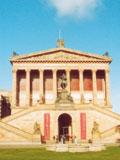Art and Culture

Art and culture are characterised by Germany’s ancient heritage, the Jewish and Christian religions, the historic development of Europe and, in modern times, the influence of the USA and, to a lesser extent, Asia and Africa.
The "Nibelungenlied", an epic poem in Middle High German about Siegfried and the Teutonic kings, is as German as the classical tragedies of Friedrich Schiller. Ancient Persia inspired Johann Wolfgang von Goethe to write the "West-Eastern Divan" in the Persian style.
The French Gothic style of architecture replaced the Romanesque in Germany.
In former times Europe was a region of culture, where the countries had a lasting mutual influence on one another.
West German fine arts and literature since 1945 have been characterised by an eagerness to experiment and absorb influences from many countries. In East Germany, however, socialist realism dominated art. Joseph Beuys was the first German to have an exhibition in New York’s Museum of Modern Art. Along with Hermann Hesse, one of Germany’s most famous authors is Nobel prize winner Günther Grass. The film adaptation of his novel "The Tin Drum" ("Die Blechtrommel") won an Oscar.

Modern architecture and product design has been shaped by Italian and Scandinavian influences. In addition to tea and filter coffee, Cafés serve espresso, cappuccino and café au lait, which is known in Germany as "Milchkaffee". Potatoes are served as a side dish along with French baguettes and Turkish flat bread.
German popular music is heavily influenced by American music. But there is also a love of classical music from Ludwig van Beethoven, German folk music and music with oriental and African influences.
Germany’s art and culture are multi-facetted and diverse as they are shaped by regional, European and International influences.
